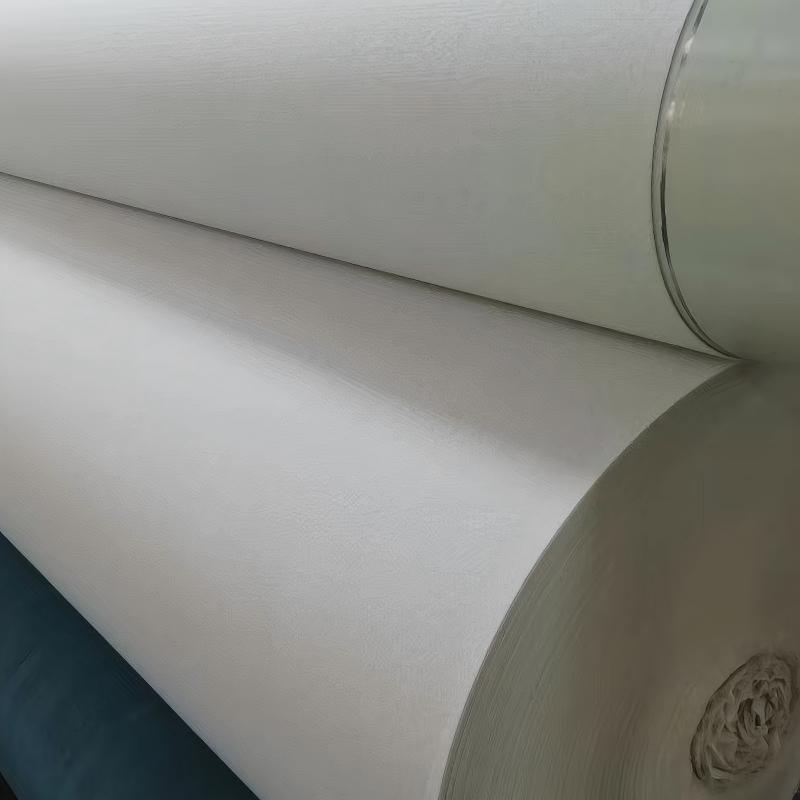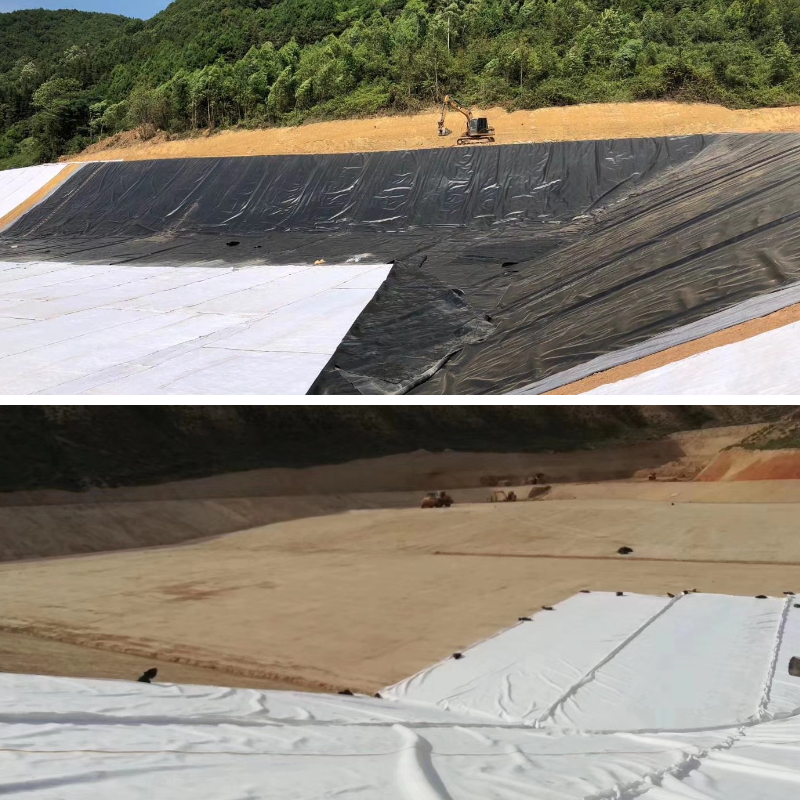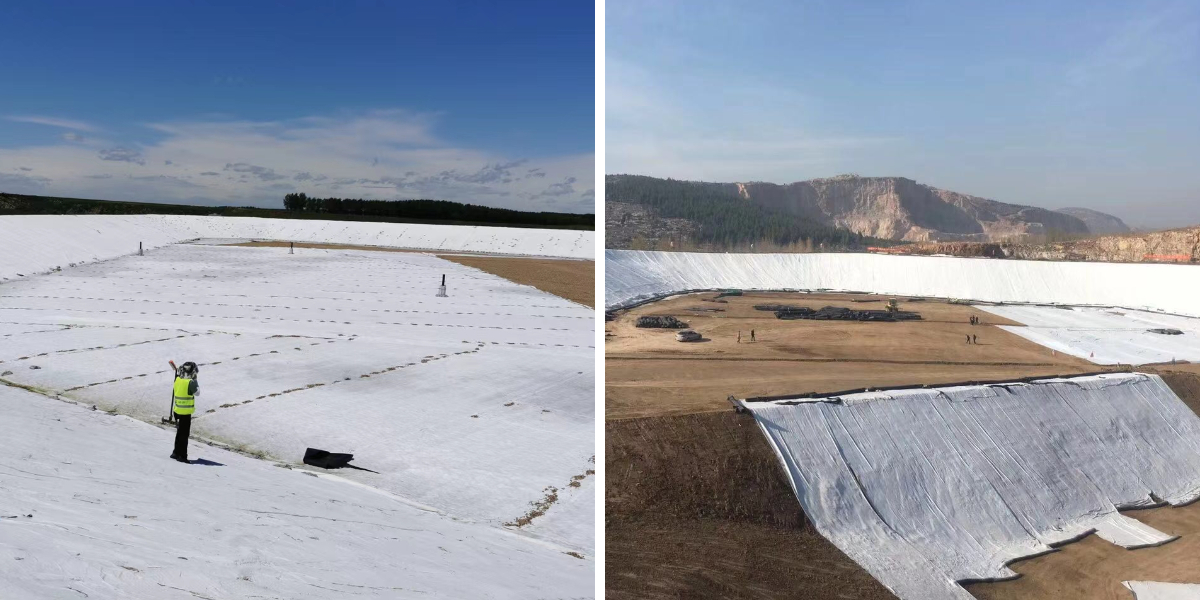Geotextile Cloth Suppliers
1. High durability materials: Made of high-quality polyester or polypropylene raw materials, resistant to ultraviolet radiation, acid and alkali corrosion, and not easily aged or broken for long-term outdoor use.
2. Strong penetration filtration: Precision textile technology creates a uniform pore structure, which can efficiently drain water and intercept sediment, preventing soil erosion.
3. Multi scenario adaptation: covering various types of products such as short silk, long silk, weaving, etc., it can meet different construction needs such as roadbed reinforcement, slope protection, water conservancy engineering, garden landscape, etc., and supports customized sizes.
4. Compliance certification guarantee: Quality inspection reports are provided for each batch of products, and construction technical guidance is provided for after-sales service.
Product Introduction:
Geotextile cloth is a kind of functional engineering material, which is made of high-quality polyester, polypropylene and other high molecular materials through precision processes such as acupuncture, knitting, and spunlacing. It has core characteristics such as high strength, anti-aging, acid and alkali resistance, good water permeability, and also has multiple functions such as isolation, filtration, reinforcement, seepage prevention, and protection. As a key auxiliary material in the field of engineering construction, its product types are diverse, including short fiber non-woven geotextiles, long fiber spun clay geotextiles, woven geotextiles, and composite geotextiles, which can be flexibly selected according to different engineering needs.
In practical applications, geotextiles can effectively solve problems such as soil erosion, structural settlement, and water leakage in engineering, while also improving engineering stability and durability, reducing construction costs and maintenance difficulties. They are widely used in various fields such as civil engineering, water conservancy and hydropower, construction and municipal engineering, and agricultural ecology, and are important supporting materials for promoting efficient construction and sustainable operation of various projects.
Product Parameters:
| project | metric | ||||||||||
| Nominal strength/(kN/m) | |||||||||||
| 6 | 9 | 12 | 18 | 24 | 30 | 36 | 48 | 54 | |||
| 1 | Longitudinal and transverse tensile strength / (kN/m) ≥ | 6 | 9 | 12 | 18 | 24 | 30 | 36 | 48 | 54 | |
| 2 | Maximum elongation at maximum load in longitudinal and transverse directions/% | 30~80 | |||||||||
| 3 | CBR top penetration strength /kN ≥ | 0.9 | 1.6 | 1.9 | 2.9 | 3.9 | 5.3 | 6.4 | 7.9 | 8.5 | |
| 4 | Longitudinal and transverse tearing strength /kN | 0.15 | 0.22 | 0.29 | 0.43 | 0.57 | 0.71 | 0.83 | 1.1 | 1.25 | |
| 5 | Equivalent aperture O.90(O95)/mm | 0.05~0.30 | |||||||||
| 6 | Vertical permeability coefficient/(cm/s) | K× (10-¹~10-), where K=1.0~9.9 | |||||||||
| 7 | Width deviation rate /% ≥ | -0.5 | |||||||||
| 8 | Unit area mass deviation rate /% ≥ | -5 | |||||||||
| 9 | Thickness deviation rate /% ≥ | -10 | |||||||||
| 10 | Thickness coefficient of variation (CV)/% ≤ | 10 | |||||||||
| 11 | Dynamic perforation | Puncture hole diameter/mm ≤ | 37 | 33 | 27 | 20 | 17 | 14 | 11 | 9 | 7 |
| 12 | Longitudinal and transverse fracture strength (grab method)/kN ≥ | 0.3 | 0.5 | 0.7 | 1.1 | 1.4 | 1.9 | 2.4 | 3 | 3.5 | |
| 13 | Ultraviolet resistance (Xenon arc lamp method) | Longitudinal and transverse strength retention rate% ≥ | 70 | ||||||||
| 14 | Ultraviolet resistance (fluorescence UV lamp method) | Longitudinal and transverse strength retention rate% ≥ | 80 | ||||||||
Product Applications:
1、 Civil engineering field: Strengthening the stability of foundation structures
Roadbed and pavement reinforcement:In the construction of highways, railways, and municipal roads, laying geotextiles between the subgrade soil layer and the base layer can effectively disperse the pressure of vehicle loads on the subgrade, reduce soil settlement and deformation. At the same time, its excellent isolation performance can prevent the mixing of soil with different particle sizes (such as preventing the movement of roadbed fillers and subgrade soil particles), avoid cracks and collapses on the road surface, and extend the service life of the road, especially suitable for construction on soft soil foundation sections.
Tunnel and underground engineering anti-seepage:Laying anti-seepage geotextile behind the tunnel lining and on the outer wall of the underground pipe gallery can form an efficient waterproof barrier, block groundwater infiltration, and protect the internal structure from erosion. When used in conjunction with geomembranes, it can also enhance interfacial friction, prevent membrane sliding, and ensure long-term drying and safety of projects such as tunnels and underground garages.
2、 Water conservancy and hydropower field: safeguarding the safety of water engineering
River and reservoir protection:Laying geotextile on the surface of river slopes and reservoir embankments can effectively resist water erosion, prevent soil loss, and provide a stable foundation for vegetation growth (when used in conjunction with ecological bags, an ecological slope protection system can be constructed). In addition, in the anti-seepage reinforcement of dams, geotextile can be used as a filter layer to filter the sediment in the permeable water and avoid the occurrence of pipe surge in the dam body.
Wastewater treatment and water environment management:In the construction of sedimentation tanks and filters in sewage treatment plants, geotextiles can be used as filtration media to intercept suspended impurities in sewage and improve water purification efficiency; In the treatment of black and odorous water bodies, laying geotextiles at the bottom of the water body can block the release of pollutants from sediment and provide a habitat for aquatic organisms, helping with ecological restoration.
3、 Building and Municipal Engineering: Improving Construction Efficiency
Construction foundation pit and slope support:During the excavation process of building foundation pits, geotextiles can be used in conjunction with support structures such as soil nails and anchor rods to form a flexible support system, enhance slope stability, and prevent soil collapse; At the same time, the drainage function of geotextile can accelerate the discharge of accumulated water inside the foundation pit, reduce the difficulty of excavation, and shorten the construction period.
Municipal Greening and Landscape Engineering:In green projects such as parks, green spaces, and rooftop gardens, geotextiles can be laid under the planting soil layer as an isolation layer to prevent soil particles from infiltrating into the drainage layer with rainwater, while ensuring smooth drainage and avoiding plant root rot; In the construction of artificial lakes and landscape water pools, geotextiles can serve as a protective layer for the anti-seepage layer, preventing the anti-seepage membrane from being punctured by sharp objects and extending the service life of landscape water facilities.
4、 Agriculture and Ecology: Supporting Sustainable Development
Agricultural Water Conservation and Soil Improvement:In agricultural irrigation systems, geotextiles can serve as protective layers for drip and sprinkler irrigation pipelines, preventing them from being blocked by soil impurities and improving irrigation efficiency; In the improvement project of saline alkali land, laying geotextiles can block the rise of underground saline water, and when used in conjunction with salt discharge pipes, accelerate soil desalination and create a suitable environment for crop growth.
Ecological Restoration and Soil and Water Conservation:In ecological restoration projects such as mine greening and barren mountain management, geotextiles can be used to cover exposed surfaces, reducing soil erosion caused by wind and rain, and providing protection for seed germination and vegetation establishment; In areas with severe soil erosion, the construction of facilities such as terraced ridges and intercepting ditches by laying geotextiles can effectively intercept sediment and restore regional ecological balance.
Geotextile Cloth has a wide range of application scenarios and strong functional specificity. In the field of civil engineering, it can be used for roadbed and pavement reinforcement to reduce settlement and extend road life. It can also achieve anti-seepage protection in tunnels and underground engineering to ensure structural safety; In the field of water conservancy and hydropower, it can provide anti erosion and anti filtration protection for rivers and reservoirs, avoid soil erosion and dam body piping, and also assist in sewage treatment and black and odorous water treatment, improving water quality and ecological restoration effects; In the fields of architecture and municipal engineering, it can be used in conjunction with supporting structures to enhance the stability of foundation pit slopes, accelerate drainage, and also serve as an isolation layer and anti-seepage protection layer in green landscape engineering, ensuring plant growth and facility durability; In the fields of agriculture and ecology, it can not only assist in water-saving irrigation of farmland and improve saline alkali land, but also play a role in preventing erosion and promoting vegetation restoration in mining greening and soil erosion control, providing comprehensive services for various engineering construction and sustainable development needs.












